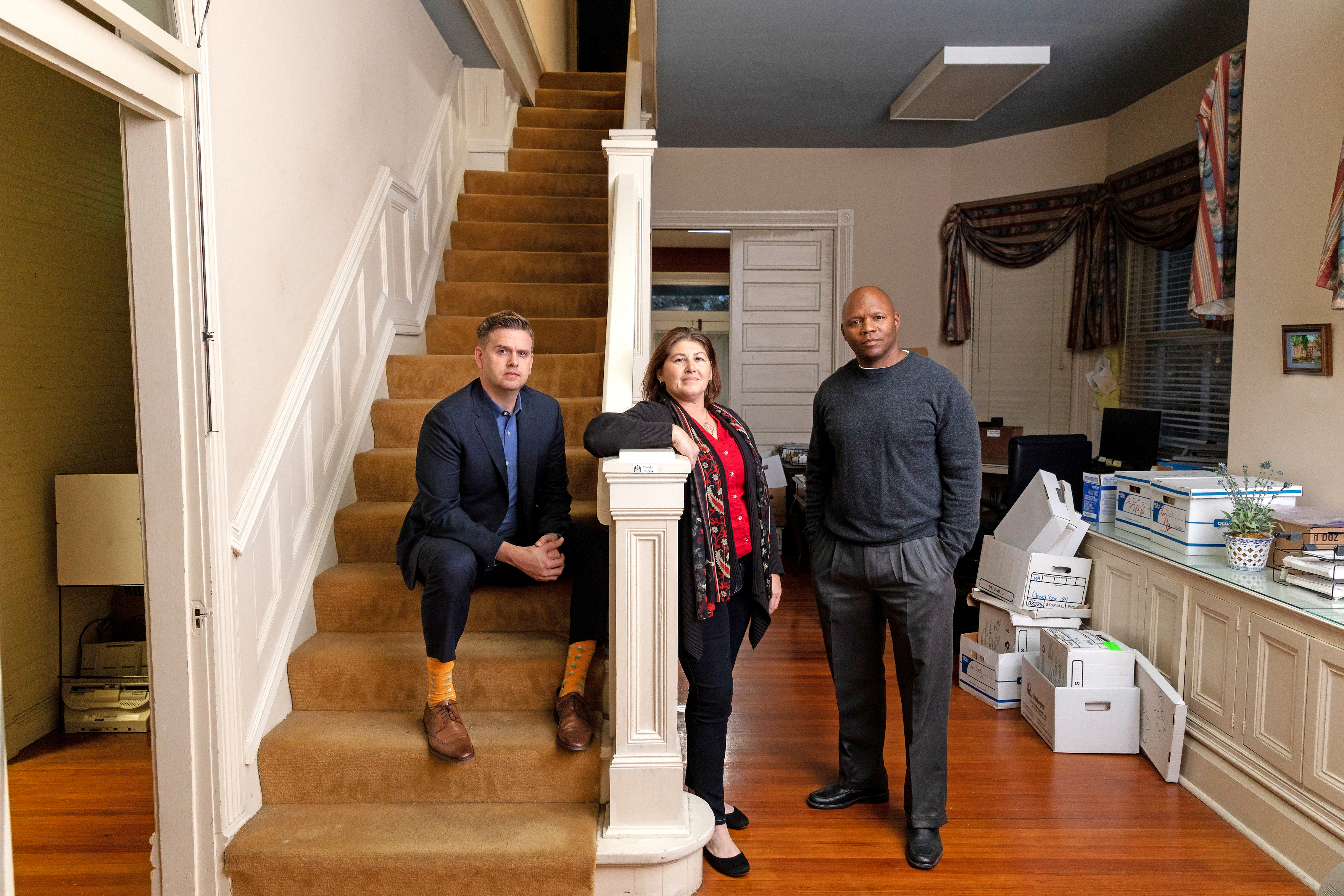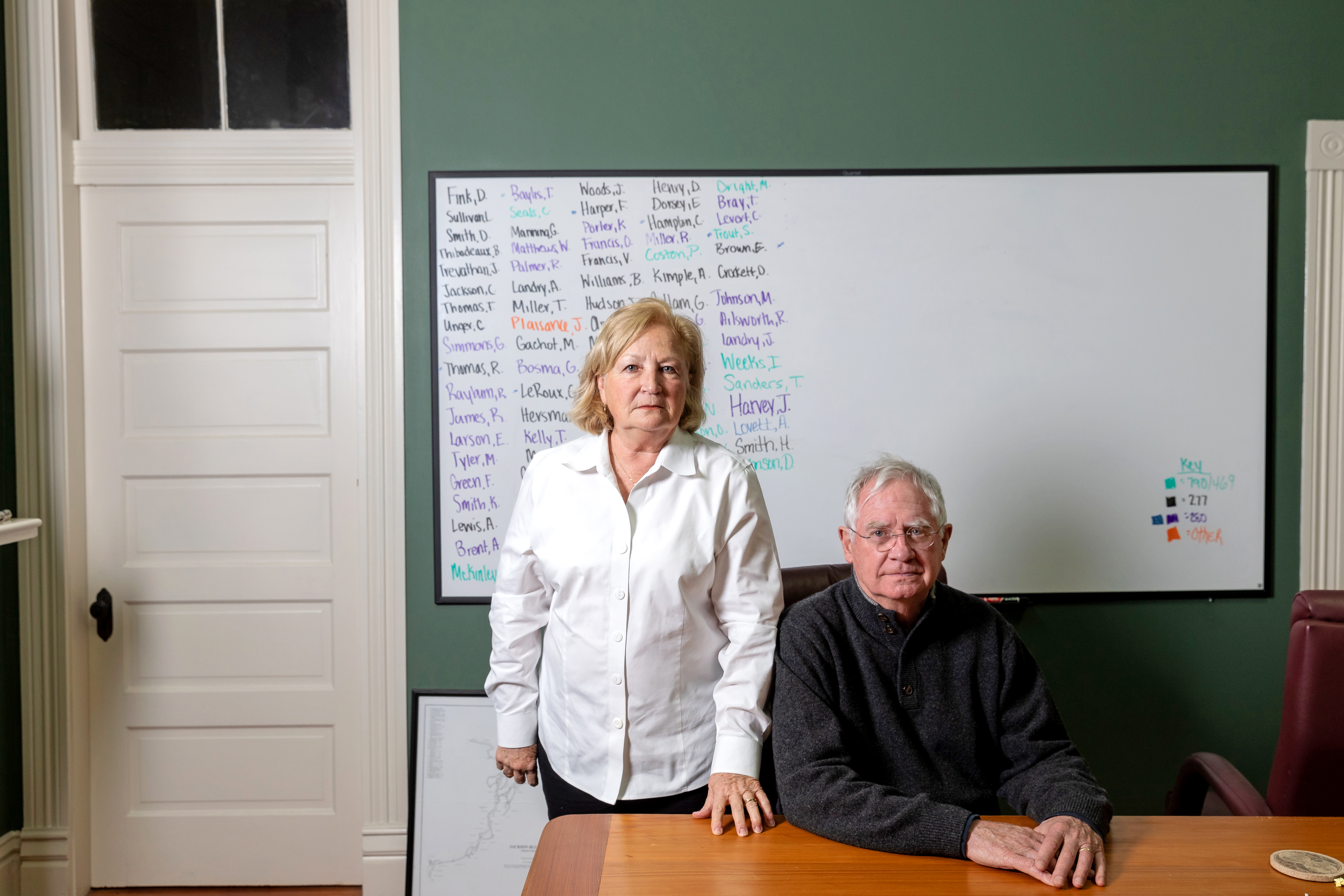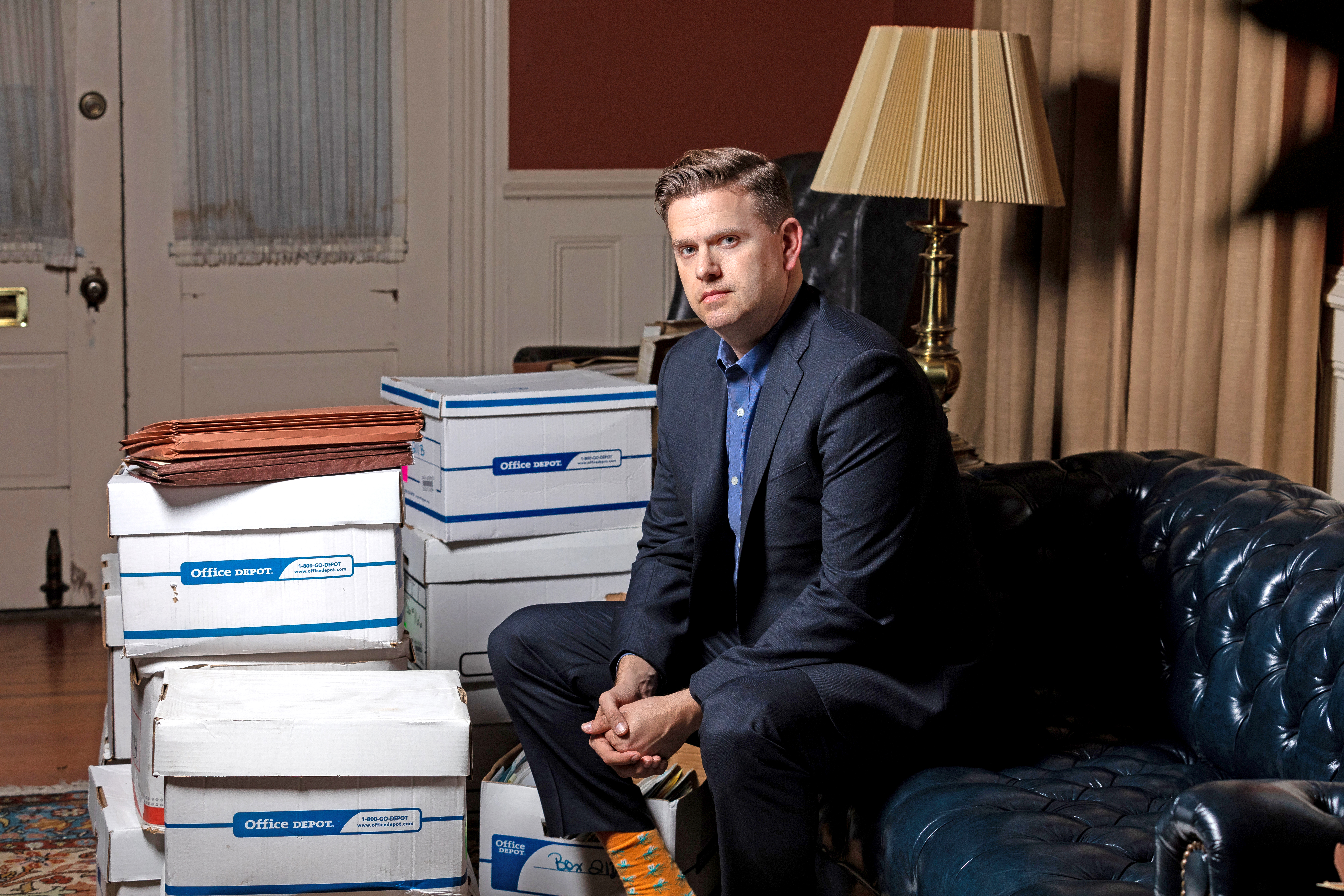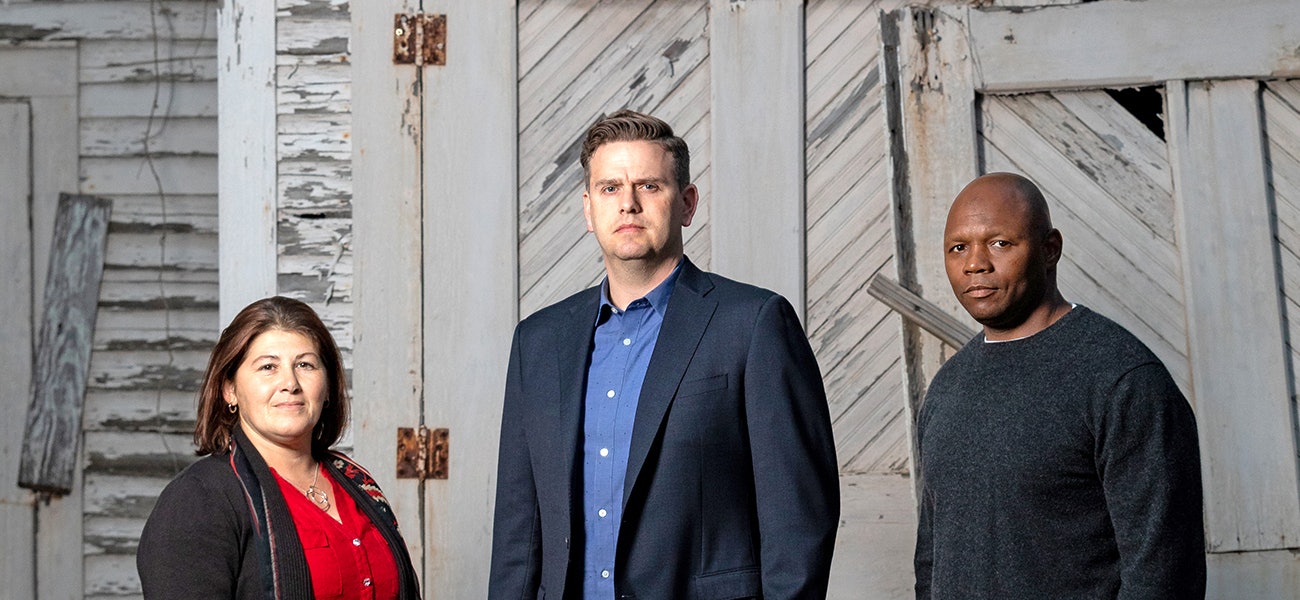The two-story light gray home that houses the Louisiana Parole Project sits on the south end of Beauregard Town, a well-maintained community known for a mix of residential homes, businesses and offices. Just across the street is the Louisiana Department of Correction’s Division of Probation and Parole.
It’s a prime location for the nonprofit and its mission: to help paroled inmates who have served 20 years or more in prison readjust to life on the outside.
The nonprofit’s slogan, “I believe in second chances,” is written everywhere. It’s in white letters across the charcoal gray T-shirts sold online, in a banner over a slideshow of photos on the nonprofit’s website and even on Facebook, with #secondchances above pictures of paroled inmates.
The shades of gray that surround the nonprofit’s story are not only on the building’s paint or in the fabric of the T-shirts, but in the people who work for LPP. All seven staff members have been convicted of crimes—most for murder—and are now helping others like them better their lives on parole.
To an outsider, it might be tough to reconcile the work they are doing with the pain they have caused. But maybe those best suited to help others find their second chances are those who know what it’s like to be given a second chance.
“Everyone on our staff has been in our clients’ shoes, and that’s important because they understand what our clients are going through,” says Executive Director Andrew Hundley, 38. “Almost half of our clients went to prison as juveniles, and almost all of our clients were first-time offenders with an isolated offense. We help turn people who are getting out and just getting by into people who are part of the community.”
In the mid-2010s, a series of rulings by the Supreme Court ended life-without-parole sentences for those under the age of 18, and created a pathway for current juvenile lifers to petition for parole.
The nonprofit serves two populations—juvenile lifers who have recently been paroled after serving 25 years in prison and those who have served 40 years or more in prison. Most of their clients are black men.
Hundley often uses the phrase, “They go from tax burdens to taxpayers,” because 33% of its 97 clients (as of December 2019) are senior citizens. As inmates, they are the most expensive to house because of their age and medical needs. It costs an average of $17,500 annually to house one inmate in Louisiana, according to New York City nonprofit the Vera Institute of Justice. But LPP estimates that it costs $38,000 a year to house an inmate above the age of 65. When they are paroled, the nonprofit pays for housing, food and personal products, and helps them find employment.
“Our clients don’t pay a penny,” Hundley says. “We cover everything so they don’t feel like they are in a bind and have to make a rash decision to meet their needs.”

Christi Cheramie, 42, was paroled from prison last February after serving 25 years for second-degree murder. She was the fourth Louisiana woman to leave prison after a life-without-parole sentence as a child, thanks to the Supreme Court decisions. She was 16 when she was with her boyfriend who stabbed and killed his aunt. Cheramie was tried as an adult and plead guilty, which she says was out of fear of a harsher punishment.
LPP helped her find a temporary job at a garden center and a car to drive to and from work, before she settled into her job at LPP as a reentry specialist.
“What I expected during transition and what I experienced were two different feelings,” Cheramie says. “Being surrounded by the Parole Project and their support was a huge help, and I learned that in spite of the fact that I was in prison for so long, it doesn’t define who I am.”
It’s a battle all the organization’s paroled clients face upon release, and Hundley knows it well.
He was 15 when he went to prison for brutally beating 14-year-old Terri Elizabeth Pitre to death and burning her body in a small town outside of Crowley. The details are grisly and hard to reconcile with the man Hundley presents himself as today—affable, educated, remorseful and hard-working.
He is tall and lean, with light brown hair and a crooked smile. On a warm day this past September, he wears a short-sleeve shirt and jeans, and when he sits down at a large conference table, his yellow rubber ducky purple socks peek out from under the cuffs of his jeans.
He graduated from LSU in May 2019, and by all accounts, was a model prisoner, serving as a mentor and leader for rehabilitation, public speaking and communication groups. In prison, he read the newspaper daily and had 20 magazine subscriptions, helping him keep up with life on the outside. He is now married to a doctor in New Orleans, where he lives and commutes to Baton Rouge for work.
He comes from an educated family that had the money to support him financially during his trial, incarceration and parole from prison.
Although he admits he was under the influence of PCP, a hallucinogenic, at the time of the murder, he does not make excuses for his actions. Instead, he points to rehabilitation and redemption, and the ability to change who you are, adding that people at 35 or 45 are not the same people they were at 15.
He talks about some of the guys he met in prison and calls them his mentors. When questioned about using the word “mentor” in the same sentence as “murderer,” he says: “If you judge someone by their worst mistake, you’re not going to like anyone. So in prison, you learn to judge people by how they treat you. And what I did when I was 15 years old was worse than what anyone else did, so who am I to throw stones?”
Those who work with Hundley speak highly of him, including Charles “Gee Gee” Hargon. The 74-year-old conservative, retired banking executive says he used to have a “lock ’em up and forget about ’em” attitude until he became involved with Hundley and the Parole Project.
“I looked up his name, his crime, and it gave me pause. It was hard to read,” Hargon says. “But then I got to know him, and he impressed me. I do believe if you spend enough time in prison and you get the right kind of support in there, you can change.”
But not everyone feels that way. Sherry Nolan works for the National Organization of Parents of Murdered Children as its volunteer coordinator and chapter developer.
“My feeling is that murder is murder, and anyone who disrespects a life and takes a life doesn’t have the right to live among society,” says Nolan, 66, of Milford, Ohio. “I believe they should live in prison for the rest of their lives.”

She speaks passionately against paroling murderers—not just on behalf of the organization, but as the mother of a murdered child. In 2001, her pregnant daughter was murdered by her son-in-law.
“There is a debt to society when it comes to murder, and it is a debt that cannot be repaid,” Nolan says. “But in our country, offenders have more rights than the victims.”
Hundley, his attorney Keith Nordyke and LSU law professor and attorney Robert Lancaster started LPP in August 2016, seven months after a Supreme Court ruling allowed 300 juvenile lifers across the state to be eligible for parole. After serving 19 years in prison, Hundley was the first juvenile lifer paroled in Louisiana.
When asked why he chose this path after prison, his answer delves into the issue of race and incarceration. Hundley is white, educated and had a good attorney and support from his family. He says because he was the first juvenile lifer released, it’s his responsibility to help those who may not have the privileges he was born with.
Jill Pasquarella, director of the Campaign to End Extreme Sentences for Youth for the Louisiana Center for Children’s Rights, says the nonprofit’s timing was right.
“They came to fruition right around the time that a lot of juvenile lifers were parole eligible,” she says. “And having an organization run by a former juvenile lifer is important to the quality of service given to clients.”
Hundley says he is thankful for his second chance but aware that his victim, Terri Elizabeth Pitre, will never have a second chance because of him.
“I have considerable amounts of remorse,” he says. “There’s nothing I will ever be able to do to atone for my crime. But I work every day, moving forward, to help build people back into society.”
Some of LPP’s clients have also served long sentences for lesser crimes, like manslaughter and armed robbery. While East Baton Rouge Parish District Attorney Hillar C. Moore III says the return to prison for those released is around 45% after three years, Hundley says LPP’s rate so far is zero.
However, the nonprofit has only been operating for about three years. And while none of LPP’s clients have been arrested since their parole, both Hundley and Moore agree intensive support is key to cutting recidivism rates. The theory is that if it takes a village to raise a child, it takes a lot more to help that same child readjust to adult life after incarceration.
“As district attorneys, we know that people are going to get out of prison,” Moore says. “We should always be on the side of trying to help those people released not return. That helps the whole community.”
LPP runs on an annual budget of $400,000, and the nonprofit receives a large chunk of its funding from grants and private donors.
The nonprofit requires all clients go through a qualification process to receive help. Incarcerees have to show they have been reformed while in prison through good behavior, participation in classes, recommendations by wardens and job skills training.
LPP coaches and mentors clients prior to release from incarceration and for about a year after parole.
The financial burden of the state’s incarceration rates was the reason Hargon got involved with LPP and now serves on its board. Pulling from his financial background, Hargon had been researching state spending and incarceration rates.
“I was not looking at this as a humanitarian issue,” he says. “It was strictly numbers for me. Are we spending money the right way? Are incarceration rates going down? We are cutting health care and higher education but spending more on incarceration. It didn’t make sense.”
He eventually became involved with LPP and recently helped the nonprofit purchase three townhouses for its clients. “It changed me,” he says. “I now firmly believe that people can change, but you have to help them. You can’t leave them on their own after being incarcerated for that long.”

Besides help with finding jobs, housing, and navigating the health care system, LPP provides instruction on social situations and interactions with the police. They also help the clients go to driving school and get a license, because many were not of driving age when incarcerated.
Louis Gibson, now 43, was 17 when he was convicted of second-degree murder for shooting another man in New Orleans during a drug turf conflict. He spent 25 years in prison before being paroled in August 2018. LPP helped him get a driver’s license, navigate the endless choices at the grocery store, enroll in financial classes and adjust to using a smartphone instead of a pager.
“When I got out, it was a totally different world, and I was a different person,” Gibson says. “I lived a life of crime going in, and I changed in prison. I had to learn how to live a legit life on the outside.”
He is now a reentry specialist for the nonprofit.
That process of reentry into the community is intensive—and it should be, officials say.
As parolees, LPP’s clients continue to serve out their sentences under supervision, just not in prison.
“The isolation part of punishment is over,” says LPP co-founder Lancaster, “but if they violate their parole or pose a public safety risk, they take them back to prison.”
Experts say juvenile offenders have a better chance for rehabilitation because their brains had not yet fully developed when committing the crime. The consideration of behavioral science helped fuel the 2016 Supreme Court rulings for juvenile lifers.
“The prefrontal cortex—the area located in the front of your brain—is not matured until 25,” says MaryElizabeth LeBoeuf, a licensed clinical psychologist who works mostly with children and adolescents in Baton Rouge. “This is the area of the brain responsible for planning and executive functioning, and for understanding that there are consequences for actions. Not even immediate consequences but long-term consequences. Does a 15-year-old understand that it’s wrong to hurt somebody? I would hope that they would have some sense of right or wrong. But do they have the ability to understand that their choices are permanent? That is the part that is not fully mature yet.”
And in accepting the science, the courts are essentially asking the public to accept that people who have committed heinous crimes, especially juveniles, have the capacity to change.
“What we’re not talking about is letting murderers out at three years,” says Ed Shihadeh, a criminologist and sociology professor at LSU. “But instead of a life term, give them a chance at parole. Not all violent crimes are the same, and treating them like they are clogs up the prison system. Give the judges the freedom to sort it out, and if it’s done properly, we can reduce prison population and save the state money.”
It’s hard to imagine a teenager sentenced to prison for decades, but it’s also hard to imagine losing a loved one to murder—and eventually seeing that murderer released.
Nolan at the National Organization of Parents of Murdered Children says one of its initiatives is to block the early release of prisoners serving time for murder or homicide. She is determined to prevent her daughter and granddaughter’s murderer from being paroled in 2041.
“My goal is to live to be 88 years old and be at that parole hearing,” she says. “I believe if he was released, he could take another life.”
District Attorney Moore says the idea of parole is heartbreaking for the victims’ families—and difficult to understand when taking into account potential changes in law.
“Some families agree to take death penalty off the table because they thought the person would get life without parole and wouldn’t get out,” Moore says. “And as DAs sitting in rooms with families, I have to remind them that yes, this is what they are getting right now, but I can’t tell you what the legislature is going to do years from now. That sentence could change. And that’s really hard to have to explain to a family.”
The story of life after prison is not filled with the same drama and strife as one might find on a TV police drama. It’s easier to think about locking the bad people up so the good people are protected, but life is simply not that simple.
“Part of the problem is that these are complex issues. And people are complex, and justice is complex,” says Mary Livers, president of LPP’s board and also an adjunct professor at LSU in the social work department. She teaches a class focused on juvenile delinquency.
“People want to make it simple—black and white, punishment, no redemption,” she says. “And then there are other people who don’t think that anyone should be in prison. That’s simplistic. The answer is in the gray.” paroleproject.org
This article was originally published in the February 2020 issue of 225 Magazine.








